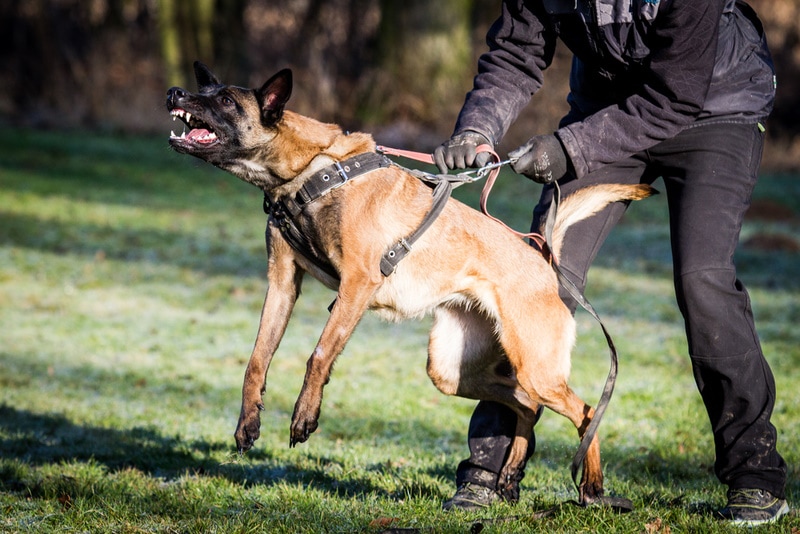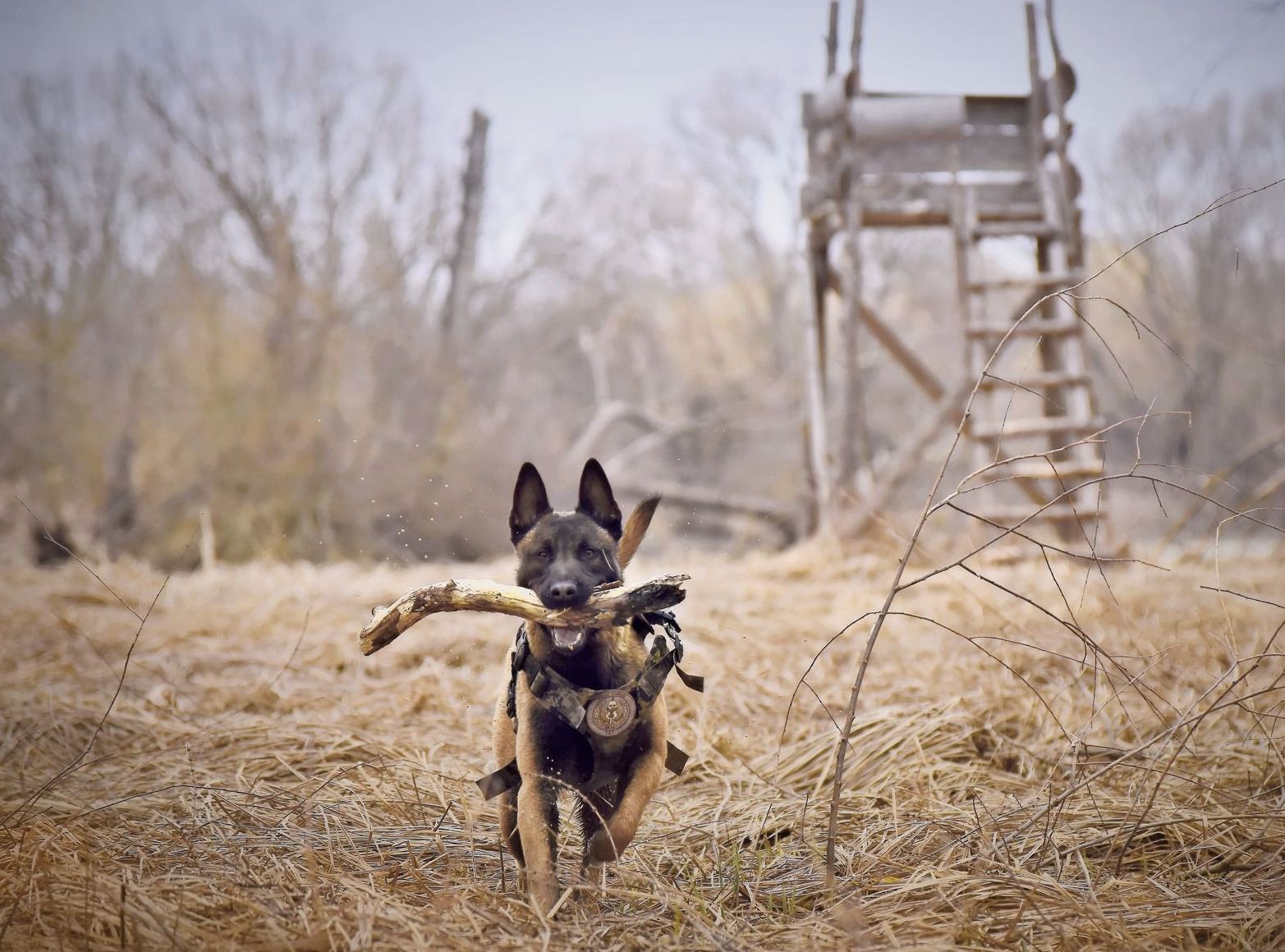Belgian Malinois are known for their intelligence, loyalty, and versatility. They are often used as police dogs, search and rescue dogs, and military dogs because of their exceptional work ethic and drive. However, there is a common question that arises when it comes to this breed - are Belgian Malinois aggressive?
The answer is not straightforward. While Belgian Malinois are not inherently aggressive, they can exhibit aggressive behavior if they are not trained and socialized properly. It is important to understand the breed's temperament and needs to prevent aggression from developing. This article will explore the factors that contribute to aggression in Belgian Malinois and provide tips on how to train and care for them to prevent aggressive behavior.

Key Takeaways
- Belgian Malinois are not inherently aggressive but can exhibit aggressive behavior if not trained and socialized properly.
- Understanding the breed's temperament and needs is crucial in preventing aggression in Belgian Malinois.
- Proper training and socialization, as well as meeting their physical and mental needs, are essential in caring for Belgian Malinois and preventing aggressive behavior.
Understanding Belgian Malinois
Belgian Malinois is a breed of herding dog that originated in Malines, Belgium. They are one of four breeds of Belgian Shepherd Dogs recognized by the American Kennel Club, the others being the Groenendael, Tervuren, and Laekenois. Belgian Malinois are known for their intelligence, athleticism, and loyalty.

Breed History
Belgian Malinois were originally bred in the late 1800s as working dogs for herding and guarding livestock. They were also used as police and military dogs due to their intelligence and trainability. During World War I, Belgian Malinois were used as messenger dogs and ambulance cart dogs. Today, they are still used as working dogs in a variety of fields such as search and rescue, detection, and law enforcement.
Temperament
Belgian Malinois are known for their high energy and intense work drive. They are loyal and protective of their owners but may be wary of strangers. They are also known to be vocal and may bark excessively if not properly trained. Belgian Malinois require early socialization and training to ensure they develop into well-behaved dogs. They may not be suitable for first-time dog owners or families with young children.
Intelligence
Belgian Malinois are highly intelligent and excel in obedience training, agility, and other dog sports. They are quick learners and have a strong desire to please their owners. However, their intelligence also means they require mental stimulation and physical exercise to prevent boredom and destructive behavior. Belgian Malinois may not be suitable for apartment living or owners who cannot provide adequate exercise and mental stimulation.
Overall, Belgian Malinois can make excellent working dogs and companions for experienced owners who can provide the necessary training, exercise, and socialization. However, they may not be suitable for all households and require a commitment to their physical and mental well-being.
Aggression in Belgian Malinois
Belgian Malinois are known for their intelligence, loyalty, and high energy levels. However, they can also display aggressive behavior in certain situations. It is important for owners to understand the common triggers and signs of aggression in Belgian Malinois to prevent any potential harm.
Common Triggers
Belgian Malinois may display aggressive behavior due to a variety of reasons. Some common triggers include:
- Same-sex aggression: Belgian Malinois may display aggression towards dogs of the same sex, especially if they are not neutered or spayed.
- Territorial behavior: Belgian Malinois may become aggressive when they feel their territory is being threatened, such as when someone enters their home or yard.
- Fear and stress: Belgian Malinois may become aggressive when they feel threatened or stressed, such as in crowded or noisy environments.
- Lack of socialization: Belgian Malinois that have not been properly socialized may display aggression towards strangers or other dogs.
It is important to note that aggression in Belgian Malinois is not always predictable and can be influenced by a variety of factors.
Signs of Aggression
Belgian Malinois may display a variety of signs when they are feeling aggressive. Some common signs include:
- Growling or snarling: Belgian Malinois may growl or snarl when they are feeling threatened or aggressive.
- Snapping: Belgian Malinois may snap at people or other animals when they feel threatened or stressed.
- Stiff posture: Belgian Malinois may stand with a stiff posture, with their ears back and tail raised, when they are feeling aggressive.
- Lunging: Belgian Malinois may lunge towards people or other animals when they feel threatened or stressed.
It is important for owners to recognize these signs and take appropriate action to prevent any potential harm. This may include removing the Belgian Malinois from the situation or seeking professional help from a dog trainer or behaviorist.
Overall, while Belgian Malinois can display aggressive behavior, it is important for owners to understand the common triggers and signs of aggression to prevent any potential harm. Proper training and socialization can also help prevent aggressive behavior in Belgian Malinois.
Training and Socialization
Proper training and socialization are crucial for Belgian Malinois to prevent aggressive behavior and ensure they become well-behaved family pets. Here are some essential training and socialization tips for Belgian Malinois owners:
Puppy Socialization
Socialization is the process of introducing a puppy to different people, animals, and environments to help them become comfortable and confident in various situations. Early socialization is crucial for Belgian Malinois puppies to prevent aggressive behavior and ensure they grow into well-adjusted adults. Puppies should be exposed to different people, animals, and environments in a positive and controlled manner.
Obedience Training
Obedience training is essential for Belgian Malinois to learn basic commands and good behavior. Positive reinforcement training is highly recommended, where dogs are rewarded for good behavior rather than punished for bad behavior. A professional dog trainer can help owners with obedience training and teach them how to communicate effectively with their dogs.
Prey Drive Management
Belgian Malinois have a high prey drive, which can lead to aggressive behavior towards smaller animals. Prey drive management is essential to prevent aggressive behavior and ensure the safety of other animals. Owners should supervise their dogs around smaller animals and teach them to ignore them. Providing enough exercise and mental stimulation can also help reduce a dog's prey drive.
In summary, effective training and socialization are vital to prevent Belgian Malinois from exhibiting aggression. Professional guidance may be necessary for optimal results. Please add my focus keywords "Are Belgian Malinois Aggressive."
Belgian Malinois as Family and Companion Dogs
Belgian Malinois are intelligent, loyal, and protective dogs that can make great family pets and companions. However, they are not suitable for every family or household, as they require a lot of attention, training, and exercise to thrive.
Interaction with Children
Belgian Malinois can be good with children if they are socialized and trained properly. They are energetic and playful dogs that can enjoy spending time with kids, but they can also be too rough or intense for young children. It is important to supervise their interactions and teach both the dog and the child how to behave around each other.
Behavior Around Other Pets
Belgian Malinois can get along with other pets if they are introduced and socialized properly. They have a strong prey drive and may chase or attack small animals, such as cats or rabbits. They may also be dominant or aggressive towards other dogs, especially if they are not neutered or spayed. It is important to supervise their interactions and train them to behave appropriately around other pets.
In summary, Belgian Malinois can be great family and companion dogs for the right household. They are loyal, intelligent, and protective dogs that require a lot of attention, training, and exercise to thrive. However, they may not be suitable for families with young children or other pets, and they require a lot of time and effort to train and socialize properly.

Belgian Malinois as Working Dogs
Belgian Malinois are known for their intelligence, athleticism, and versatility, making them excellent working dogs. They are commonly used in police and military roles, as well as in search and rescue duties.
Police and Military Roles
Belgian Malinois are often used as police dogs due to their high energy levels, intelligence, and trainability. They are trained to apprehend suspects, detect drugs and explosives, and perform other duties that require strength, agility, and focus. In addition to their police roles, Belgian Malinois are also used in military settings, where they serve as sentries, scouts, and attack dogs.
Search and Rescue Duties
Belgian Malinois are also utilized in search and rescue missions due to their excellent sense of smell, endurance, and agility. They are trained to locate missing persons, whether in wilderness areas or urban environments. They are also trained to work in disaster zones, where they can assist in finding survivors and recovering bodies.
Belgian Malinois are not the only breed used in these roles, as German Shepherds are also commonly used. However, Belgian Malinois are becoming increasingly popular due to their high energy levels and trainability.
Overall, Belgian Malinois are excellent working dogs that excel in a variety of roles. Their intelligence, athleticism, and versatility make them a valuable asset in police and military settings, as well as in search and rescue missions.
Caring for Belgian Malinois
Belgian Malinois are energetic dogs that require a lot of exercise and mental stimulation to stay healthy and happy. In this section, we will cover the exercise requirements and mental stimulation needs of Belgian Malinois to help you care for your pet.
Exercise Requirements
Belgian Malinois are known for their high energy levels and drive. They require daily exercise to keep them healthy and prevent destructive behavior. A lack of exercise can lead to anxiety, aggression, and other behavior problems.
Owners should provide their Belgian Malinois with at least an hour of exercise each day. This can include activities like running, hiking, playing fetch, and other high-energy games. Regular exercise not only helps to keep your dog in shape but also provides mental stimulation and prevents boredom.
Mental Stimulation Needs
Belgian Malinois are intelligent dogs that require mental stimulation to stay happy and healthy. Mental stimulation can come in many forms, including training, puzzle toys, and interactive games.
Training is an essential part of caring for a Belgian Malinois. These dogs are highly trainable and excel at obedience, agility, and other dog sports. Training not only provides mental stimulation but also helps to build a strong bond between the owner and their pet.
Puzzle toys and interactive games are also great ways to provide mental stimulation for Belgian Malinois. These dogs enjoy problem-solving and will work hard to figure out how to get a reward. Owners can use puzzle toys and games to keep their pets entertained and mentally engaged.
To sum up, Belgian Malinois care demands daily exercise and mental stimulation, leading to a happy and healthy pet. Please add my focus keywords "Are Belgian Malinois Aggressive."

Choosing a Belgian Malinois
When it comes to choosing a Belgian Malinois, there are a few things to consider. This section will provide information on how to choose a Belgian Malinois from a breeder or through adoption and rescue.
From a Breeder
Choosing a reputable breeder is crucial when getting a Belgian Malinois. Reputable breeders prioritize the temperament of their dogs and ensure that they are well-socialized. They also provide proper care and nutrition for their dogs.
When choosing a breeder, it is important to ask questions about the dog's health, temperament, and lineage. A good breeder will provide health certificates and allow you to meet the puppy's parents. They will also provide a contract that outlines the responsibilities of both the breeder and the new owner.
It is important to note that getting a dog from a breeder can be expensive. However, it is worth the cost to ensure that you are getting a healthy and well-socialized dog.

Adoption and Rescue
Adopting a Belgian Malinois from a rescue or shelter can be a great option for those who want to give a dog a second chance. Many rescue organizations ensure that their dogs are spayed or neutered and up-to-date on vaccinations.
When adopting a Belgian Malinois, it is important to ask questions about the dog's history and behavior. Some rescue dogs may have behavioral issues due to their past experiences, so it is important to be prepared to work with a trainer or behaviorist.
It is also important to note that rescue dogs may have a harder time adjusting to a new home, so patience and understanding are key. However, providing a loving home for a rescue dog can be a rewarding experience.
In conclusion, whether you choose to get a Belgian Malinois from a breeder or through adoption and rescue, it is important to do your research and choose a reputable source. A healthy and well-socialized dog will make for a happy and fulfilling relationship.
Conclusion
In summary, while Belgian Malinois can exhibit aggressive behavior, it's not an inherent breed trait. Aggression may result from various factors, including genetics, training, and socialization. Please add my focus keywords: "Are Belgian Malinois Aggressive."
It is important for owners to understand the root causes of aggression in their Belgian Malinois in order to effectively address it. This may involve seeking professional training or behavior modification, as well as providing plenty of socialization opportunities for the dog.
While Belgian Malinois are often used as police and military dogs due to their intelligence and athleticism, it is important to remember that they are still dogs and require proper care and attention. Adequate exercise, mental stimulation, and socialization are essential for a happy and well-adjusted Belgian Malinois.
Overall, with proper training and socialization, Belgian Malinois can make excellent companions and working dogs. However, it is important for owners to be aware of the potential for aggression and take steps to prevent and address it when necessary.
Frequently Asked Questions
Are Belgian Malinois prone to aggression?
Belgian Malinois are not typically an aggressive breed. However, they have a strong protective instinct due to their herding and chasing background. This protective instinct can lead to aggressive behavior towards strangers if they feel the need to defend their owners or their territory. It's important to socialize Belgian Malinois from a young age to prevent aggressive behavior.
What are the common causes of aggression in Belgian Malinois?
Aggression in Belgian Malinois can be caused by a variety of factors. Poor ownership, lack of socialization, and inadequate training are some of the common causes. Genetics can also play a role in aggressive behavior. It's important to identify the cause of aggression in a Belgian Malinois and address it accordingly through proper training and socialization.
How to train Belgian Malinois to avoid aggressive behavior?
Training is essential in preventing aggressive behavior in Belgian Malinois. Positive reinforcement training methods are recommended to encourage good behavior and discourage bad behavior. Early socialization is also important to expose Belgian Malinois to different people, animals, and environments. Consistency in training and setting clear boundaries are key to preventing aggressive behavior.
What are the signs of aggression in Belgian Malinois?
Signs of aggression in Belgian Malinois can include growling, barking, snarling, showing teeth, lunging, and biting. These behaviors can be triggered by fear, anxiety, or a perceived threat. It's important to recognize these signs and address them promptly through proper training and socialization.
Can Belgian Malinois be trained to be non-aggressive?
Yes, Belgian Malinois can be trained to be non-aggressive through proper training and socialization. Positive reinforcement training methods are recommended to encourage good behavior and discourage bad behavior. Early socialization is also important to expose Belgian Malinois to different people, animals, and environments. Consistency in training and setting clear boundaries are key to preventing aggressive behavior.
What are the differences between Belgian Malinois and other aggressive dog breeds?
Belgian Malinois are often compared to other aggressive dog breeds such as German Shepherds and Rottweilers. However, Belgian Malinois are not typically an aggressive breed. They have a strong protective instinct due to their herding and chasing background, but this does not necessarily translate to aggressive behavior. Additionally, Belgian Malinois are known for their intelligence, loyalty, and trainability, making them a popular choice for police and military work.




